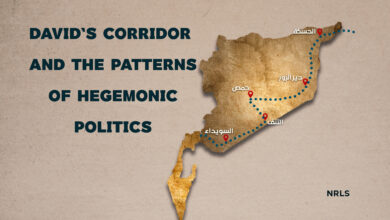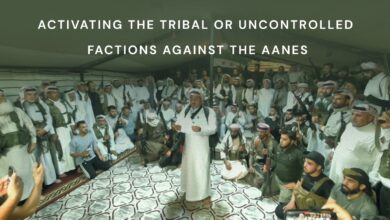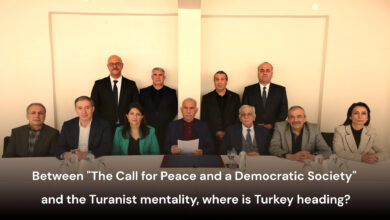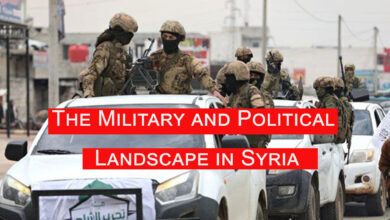Erdogan’s rapprochement with Syrian regime aims at asserting himself in northern Syria
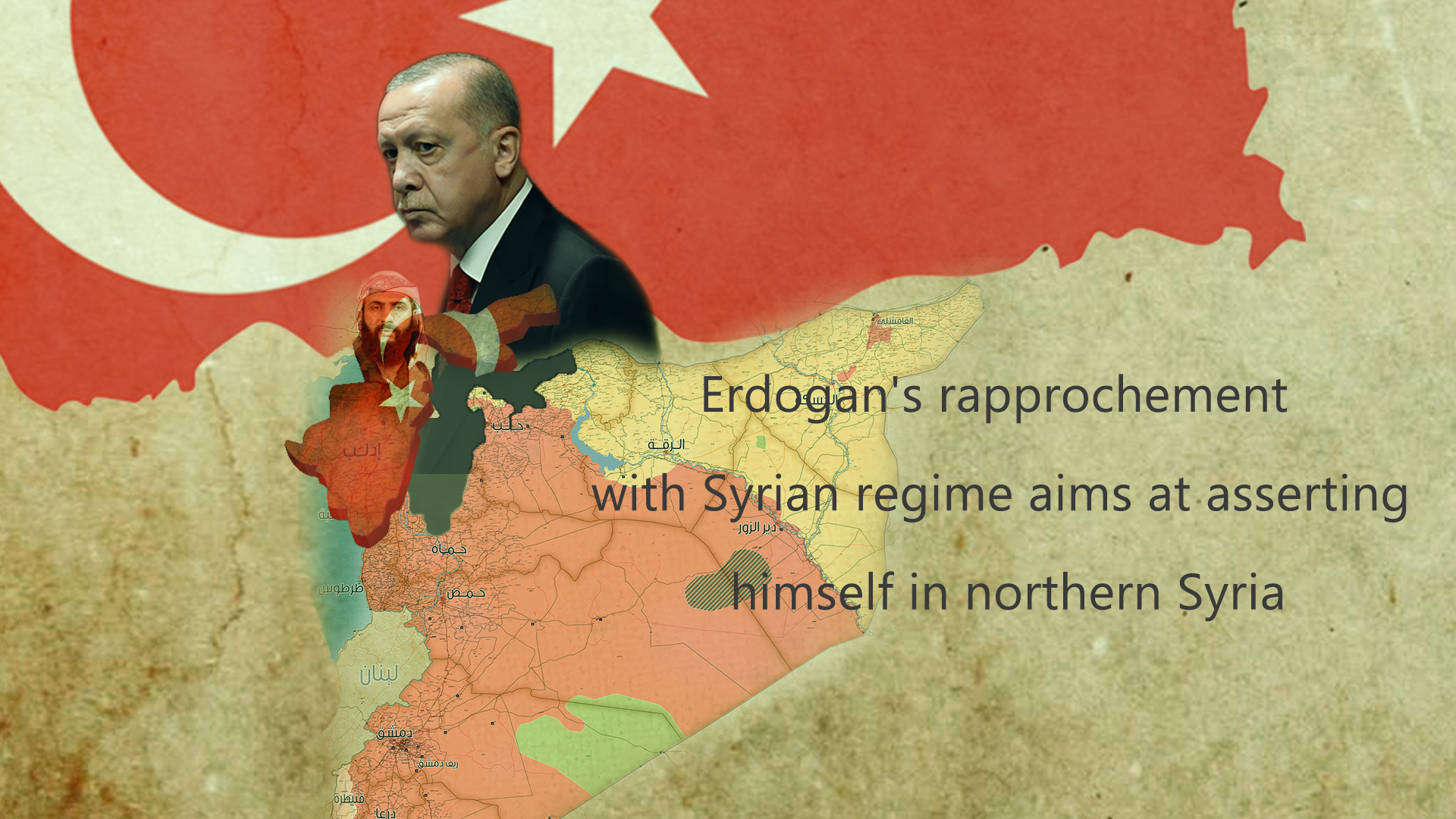
Undoubtedly, the most prominent event these days is the issue of rapprochement between the Turkish regime and the Syrian opposition on one hand with the Syrian regime on the other. Many observers expect that Erdogan will abandon the opposition Syrian National Coalition (SNC) and its affiliated armed factions, as he did in Aleppo and other regions of Syria years ago, in exchange for ensuring his success in the upcoming Turkish elections. Others describe the matter as temporary tactics as long as Turkey insists on the UN Resolution 2254. We, in turn, ask and wonder about the implications of Muhammad al-Julani’s recent statements on this matter. Will Erdogan really abandon the opposition to ensure his success in the upcoming elections? Will he hand over the Syrian opposition and northern Syria to the Syrian regime? Are there hidden intentions behind this? What are the possible motives, goals and scenarios? Through our analysis, we will try to answer these and many other questions.
The tripartite meeting that brought together the ministers of defense of Turkey, Syria and Russia in Moscow and the issue of the rapprochement between Turkey and the Syrian opposition on one hand and the Syrian regime on the other comes within prior understandings and a continuation of the Tehran summit, as Iran has made unremitting efforts for the convergence of the Turkish and Syrian regimes since the second half of 2022. Despite the contradictions and historical conflict between Turkey and Iran on the one hand, and between Turkey and Russia on the other, there are common denominators linking these parties with each other in Syria. Inevitably, any rapprochement or reconciliation between the Turkish and the Syrian regimes will benefit Russia and Turkey in the first place, while the biggest loser will be the Syrian people in the northeast and northwest. The common denominator among Turkey, Syria, Iran and Russia is striking the union of the Syrian communities, eliminating the Autonomous Administration of North and East Syria (AANES) which was formed with the efforts and sacrifices of thousands of martyrs, and targeting the American presence in Syria. On the other hand, we hear the holding of an expanded meeting of the Syrian clans under the supervision of Turkey in the city of Urfa to mobilize and incite them against the AANES. The regime in Syria also seeks to play on the clans and incite them against the AANES. This was clear in the recent events in Deir ez-Zor and some other areas to create strife and chaos. Therefore, the convergence of the Turkish and Syrian regimes endangers the American interests as well. Despite the repeated statements by American officials of the need to avoid normalization with the Assad regime, Turkey ignores this and proceeds and continues its positions regarding normalization and expansionist policies in the region. The US has not shown any strict positions to block the path to Turkey’s interventions in north and east Syria and the entire region. This is what gives Turkey the audacity to persist in its expansionist policies. If the US does not break the wall of its silence, then this means that the Turkish policies in the region are in the interest of the US in some respects.
Undoubtedly, any kind of reconciliation between the Syrian and Turkish regimes is not possible in a short period of time because the two parties have lost confidence in each other. They may take some steps to show goodwill towards the other but we exclude that any reconciliation will take place in the manner required by both parties in a short period. However, there is a high possibility that the Adana Agreement will be activated to include 32-35 km instead of 5 km. This can be proved when the Turkish drones enter the Syrian airspace at a depth of more than 40 km, all the way to Hasakah Governorate. This puts us in doubt that the two parties agreed to modify the Adana Agreement during their security meetings. Of course, the threats and attacks that Turkey is making against the Syrian Democratic Forces (SDF) and the AANES are in the interest of the Syrian regime in the first place because the regime forces do not dare alone to attack the SDF, especially in light of the presence of the US-led Global Coalition forces in these areas, so both Russia and Syria want that the Turkish threats and attacks will always be like a sword hanging over the head of both the SDF and the AANES, and the Syrian regime is slowly advancing in northeastern Syria to extend its control. In conclusion, both Syria and Turkey find the Democratic Nation Project a danger to them, and its success in Syria means to generalize it to those countries as well. Therefore, both of them agree and work to undermine the AANES and to eliminate the presence of the Kurds to a depth of 35 km, i.e. to eliminate Rojava as a whole.
As for the west of the Euphrates River and other areas under the occupation of Turkey, will the people who were killed, displaced, their villages and cities were destroyed, and were subjected to persecution at the hands of the Syrian regime, accept reconciliation easily and forget everything that happened?
It seems that there is a clear division in terms of the form and nature of the demonstrations and discourses against the statements of the Turkish officials and the Turkish president, which took place in more than fifty locations. Most people deplore the statements made by the Turkish officials about rapprochement with the Syrian regime in the areas occupied by Turkey. Furthermore, the scene of the attack on Salem al-Meslet, the president of the SNC, and his expulsion from the demonstrations where the angry people in the city of Azaz called him a Shabiha. All of this indicates that the northwestern region of Syria is also on the verge of a new phase, as part of the opposition and the armed factions that are sheltering under the Turkish mantle will support Turkey regarding the issue of rapprochement with the Syrian regime, while the remaining part of the opposition will resort to those who finance and embrace it, and we may find more openness from the European and American sides towards the Syrian opposition in the coming days.
There are three goals for Erdogan behind the rapprochement with the Syrian regime:
First: Erdogan wants to withdraw the card of returning the refugees to Syria from the hands of his opponents (the Turkish opposition) in order to get rid of the burden of refugees, and thus guarantee the results of the elections.
Second: Erdogan wants to move the Syrian crisis and revive it after the stagnation it went through over the past years. He wants the keys to the crisis and the initiative to be in his hands so that everything is under his control and according to what he plans. We know that the Syrian crisis has been frozen for several years, and no solutions are looming on the horizon. Additionally, the superpowers do not allow fighting by any party, and there is also no international will to solve the Syrian crisis. So that shuffling the cards before the Turkish elections may be in the interest of the Turkish regime and forcing the US to take new positions that are in its interest.
Third: Through statements about rapprochement, Erdogan and his officials, in coordination with Hayat Tahrir al-Sham (HTS), are strengthening and establishing their foothold in the occupied areas in Syria. Although al-Julani’s first criticism of the tripartite meeting was harsh, describing it as a dangerous deviation and as affecting the goals of the revolution, he softened his rhetoric in his second statement towards Turkey. Erdogan’s and al-Julani’s statements may be contradictory and somewhat different in this matter, but in essence they are one, two sides of the same coin. There are periodic meetings held between the Turkish Ministry of Defense and the Turkish Security Forces on one hand and the HTS from time to time, and there is high-level coordination between the two parties, especially some after its expansion to the areas controlled by the Turkish state.
Turkey, through its maneuvers in reconciliation with the Syrian regime, has revived the Syrian crisis again and shed light on it. Turkey will keep the Syrian crisis the most prominent event to influence the American policy. It achieved many goals it had planned in Syria. From now on, the HTS will run the areas but under the control of the Turkish influence, i.e. the loyalty of the occupied Sunni areas in northwestern Syria will be to Turkey, and Turkey will have the upper hand and the spoken word in them.
The matter of the Syrian refugees in Turkey has become a burden on Turkey, as the Turkish opposition, especially the left-wing Republican People’s Party (CHP), uses this issue against Erdogan. In this regard, the CHP sent a message to the Syrian president, in which it said: “Do not reconcile with Erdogan, and if we win the elections, we will withdraw directly from Syria, and we will return the refugees to Syria.”
Therefore, Erdogan wants to take the matter of the refugees from the CHP and enters the line with the Syrian regime himself in order to satisfy the Turkish people. However, Turkey’s main goal in this rapprochement is to eliminate the AANES and the SDF. It will also incite the regime against the SDF and the AANES. At the same time, Turkey will not allow the Kurds to gain their rights within the Syrian constitution.
The issue of reconciliation and the return of the Syrian refugees by force is not possible in Syria, and the conditions for the return are not available. The Erdogan and Assad regimes may reconcile, but the people who have been displaced and suffered cannot accept reconciliation with the Assad regime so quickly, and Erdogan will not withdraw from Syrian territory easily because the goals he set in Syria and Iraq are strategic ones. He is like Bashar al-Assad. He will not easily relinquish the throne of power. Erdogan, who has prepared for his authority for 20 years, will not give up power easily. If he not, the situation will become similar to that in Iran and Syria.
Also, one can notice that the rapprochement between Turkey and Syria has turned into a real referendum on the ground in the occupied north to assert itself more and more, as the people in these areas were given the option to either say: No to the regime, or the situation remains as it is without change (i.e. Yes to Erdogan). This in itself is support and endorsement for Erdogan’s regime to assert itself on the Syrian land, and thus raise the ceiling of its demands with the Syrian regime in the negotiation that it will conduct with it in the future.
Erdogan knows very well that the majority of the people in these areas will not choose the regime if they are given a choice, and with this referendum his goal may be achieved automatically. With this maneuver, he may also satisfy Russia and say to it, “In fact, we would have liked the opposition to reconcile with the regime as well, but the opposition is not satisfied.”
It seems that an agreement has been reached between Turkey and the HTS to manage the northern areas of Syria according to a specific mechanism so that Turkey will have the upper hand in these areas. This means that everything is done according to the plan drawn, which is the formation of a Sunni belt along the entire border strip to complete the demographic change scheme. Erdogan’s assertion and his insistence from time to time on the occupation of Kobani comes within the framework of linking all these areas together, meaning that northern Syria, starting from Jarablus, al-Bab, Azaz and Afrin to the areas under the Turkish control reaching the far west of Syria (Idlib), is automatically linked to the HTS, and these will be the areas of Turkish influence and will be run by al-Julani and the Turkish regime together.
So we have three future scenarios:
The first scenario: If the situation is heading towards detente and a solution to the Syrian crisis in accordance with the UN Security Council Resolution 2254, then Turkey must leave the Syrian territory immediately, then Turkey will leave with all its military forces and al-Julani will remain the shepherd over these areas as he is a Syrian national to be an agent for Turkey to manage the areas they seized in Syria. Let us not forget that Turkey’s allowing the expansion of the HTS in Afrin and other areas falls within this framework. That is, an administrative system of moderate Sunnis, not extremists, will be established in the area under the control of the HTS and the Turkish occupation, and the US and the Western countries will not oppose it. This means that there will be three areas of influence in Syria: a Sunni area in Idlib and the areas that fall under the Turkish occupation, an Alawite area with the Sunnis participating in the rule with Bashar al-Assad, and an area in north and northeast Syria run by the AANES with the participation of all communities including the Kurds, Arabs, Assyrians, Syriacs and others.
The second scenario: If the situation worsens and Syria heads towards division, then Turkey will maintain its military positions and posts on the ground in north and northwest Syria and will not leave it. Furthermore, it will hold another referendum and annex these lands to Turkey similar to what it did in Sanjak of Alexandretta. If the international forces do not intervene to stop it, then Turkey would have achieved its strategy that it had always dreamed of, which is the Misak-ı Millî that it set before its eyes to reach its goals, carving out parts of Syria and Iraq as planned and annexing them to Turkey.
The third scenario: The reconciliation with the SDF and the AANES, and this proposal was an American one. After Turkish statements about reconciliation with the Syrian regime and the reactions of the population in northwestern Syria and the lack of reconciliation with the regime, the atmosphere has become more prepared than ever, and here the role also falls on the SDF and the AANES to show some flexibility and openness and attract those who can be attracted from the moderate opposition. If the US and Europe intervened and put their weight in this area, they would be able to influence the opposition and get it out from under the Turkish cloak, but the problem lies in the fact that the opposition is not independent and its decision is not in its hands, so the process of bringing about a rapprochement between northeastern and northwestern Syria will not succeed. The success of the operation needs the consent of Turkey.
Accordingly, the US mediated between the Kurds and Turkey in order to bring the views of the two parties closer in the past periods, but it did not succeed. Undoubtedly, in the current circumstances, the issue of Turkey’s reconciliation with the Kurds is out of the question because the mentality that controls the Turkish regime is that of denial, so it requires a radical change because Turkey does not accept the indigenous cultures and nations of the region. If we perceive a serious change in the ideology and structure of the deep state in Turkey towards the Kurds and the recognition of their rights officially and constitutionally in northern Kurdistan (southeast Turkey), then we can talk about uniting northeastern and northwestern Syria. This will be the beginning of resolving the Kurdish issue and recognizing the rights of the Kurds in northern Kurdistan as well. We do not rule out that Erdogan and his regime will resume negotiations with the PKK leader Abdullah Ocalan in his prison. The possibility of rapprochement between northeastern and northwestern Syria remains dependent on the cessation of the denial policy pursued by Turkey, the acceptance and official recognition of the rights of the Kurds in Rojava (north and northeast Syria) and northern Kurdistan by the Turkish regime, and the start of public negotiations with Ocalan in Imrali to establish a lasting and comprehensive peace in the region.
Erdogan’s regime is economically and politically shaken and we are on the verge of early Turkish elections, so if Erdogan does not take serious steps towards resolving the Kurdish issue, he is likely to lose the next electoral battle. To achieve some kind of victory on the ground in the elections, he is in dire need of the votes of the Kurds in Turkey, hence comes the importance of negotiations with Ocalan. The Erdogan regime has no choice but to move forward with the peace process that it started after 2010 with Mr. Ocalan to solve the Kurdish issue and stopped in 2014. The keys to resolving the Kurdish, Syrian, and the Middle East issues are in Imrali (the place where Ocalan has been imprisoned in since 1999). Mr. Ocalan presented an alternative political-administrative intellectual system for running the Middle East to get out of the impasse in which the capitalist world order, based on nation-states that exterminated peoples and fused cultures, occurred. Mr. Ocalan proposed solutions to the Kurdish issue and the outstanding Middle Eastern problems, including the issue of Palestine and Israel.
Conclusion:
We rule out that reconciliation will take place overnight between the Turkish and the Syrian regimes because the points of disagreement are more than those of agreement. The only common denominator between the two regimes is the hostility to the Kurds and the end of the AANES. A meeting will be held between the foreign ministers of the two countries to draw up plans and goals, and the expected meeting between Erdogan and Bashar al-Assad may take place, but the actual steps will be after the Turkish elections. We also rule out the second scenario and the division of Syria in the current situation. There is no change in the political map in the Middle East at present, but the change will be in the form of the regimes.
The third scenario, i.e. the reconciliation with the SDF and the unification of northeastern and northwestern Syria is impossible in light of Turkey’s intransigence in not recognizing the rights of the Kurds unless the US puts pressure on it or persuades it to change its stance towards the Kurds.
As for the first scenario, that is the establishment of three areas; Sunni, Alawites, and AANES is very likely and a probable one scenario which is similar to what the US did in Iraq, and it is not excluded that it will be applied here as well.
Striking security and stability, and pushing the region towards the abyss in northeastern Syria and other areas is in the interest of ISIS and its revival, and limiting the work of the Coalition forces. What Russia, Turkey, Iran and Syria want behind the reconciliation is to extend the hegemony of the Syrian regime over all regions as it was before 2011. So, it becomes clear that the AANES, the Global Coalition, and the US forces are within the circle of their goals. Therefore, it is necessary for all the communities of north and northeast Syria to unite in standing up to these plotted schemes, confronting them and relying on themselves to defend their gains until the last breath. The Coalition forces also have a great responsibility to protect the communities of the region that defended the dignity of humanity and fought ISIS on behalf of the world. The participants in the tripartite meeting among Turkey, Russia, and Syria in addition to Iran, are experiencing a major crisis, and the three regimes of Assad, Erdogan, and Putin are all isolated from the international community and live alone under a suffocating siege, dependent on and sheltering from each other. After a hundred years of the Treaty of Lausanne, there is no escape from the winds of change in Syria, Iran and Turkey, and the Kurds will have a place and a role in the new Middle East and the democratization of these countries. The Kurds have become an important factor in the political equation in the Middle East, and they will have a leading role in the future.
Rojava Center for Strategic Studies
